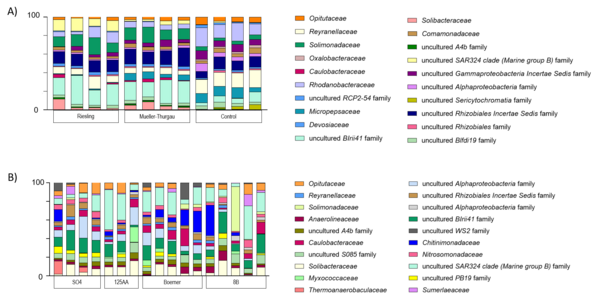A group of researchers including members from the Geisenheim Department of Soil Science and Plant Nutrition has published an article in Oeno One – Vine and Wine – Open Access Journal Vol. 57 No.3 (2023) on the effects of scion and rootstock genotype on bacterial communities in the grapevine rhizosphere. The title of the article is: The transcriptionally active bacterial communities of grapevine rhizosphere in dependence on rootstock and scion variety.
Abstract
The rhizosphere is where crucial processes for the productivity of viticultural systems occur. The composition of the bacterial communities associated with the rhizosphere of grapevines is known to depend on plant genotype. However, the genotype of grafted grapevines differs between scion and rootstock; the role of each genotype is unclear. To untangle the effect of scion and rootstock, the rRNA (V4–V5 region of 16S rRNA) extracted from the rhizosphere of the grape varieties Riesling and Mueller-Thurgau ungrafted vs grafted on different rootstocks was sequenced. The bioinformatic analysis with tools designed to be robust for compositional data showed that the investigated rootstocks or scions or combinations, respectively, recruited bacterial communities with distinguishable traits. Statistical differences were revealed between ungrafted Riesling vs Mueller-Thurgau, between grafted Riesling vs ungrafted Riesling, and between ungrafted Mueller-Thurgau vs grafted Mueller-Thurgau. Thus, confirming the role of scion and rootstock genotype as a driver of the structure and composition of bacterial communities in the rhizosphere of grapevines.
Further studies are needed to better understand the different microorganisms in the grapevine rhizosphere in relation to scion-rootstock combinations. In addition, the effects on grapevine growth and health as well as wine quality need to be determined.
Authors
- Leonie Dries, Department of Soil Science and Plant Nutrition, Hochschule Geisenheim University
- Stefan Ratering, Research Center for BioSystems, Land Use, and Nutrition (IFZ), Institute of Applied Microbiology, Justus-Liebig University Giessen
- Simone Bussotti, AGRION, Fondazione per la Ricerca l’Innovazione e lo Sviluppo Tecnologico dell’Agricoltura Piemontese, Manta (CN)
- Otmar Löhnertz, Department of Soil Science and Plant Nutrition, Hochschule Geisenheim University
- Anne Vortkamp, REACH EUREGIO Start-up Center, University of Muenster
- Sylvia Schnell, Research Center for BioSystems, Land Use, and Nutrition (IFZ), Institute of Applied Microbiology, Justus-Liebig University Giessen
About OENO One
OENO One (Impact factor = 2.9) was founded in 2016 by a group of leading European universities and research institutes in the field of vine, grape and wine sciences, replacing the Journal International des Sciences de la Vigne et du Vin (JISVV) after almost 50 years of existence (1967-2016, formerly Connaissance de la Vigne et du Vin). The journal is published by IVES - International Viticulture and Enology Society. OENO One is peer-reviewed and among the top journals in the industry. It has an exceptional Editorial Board of highly respected editors and associate editors, covering a broad range of topics in viticulture and enology.



